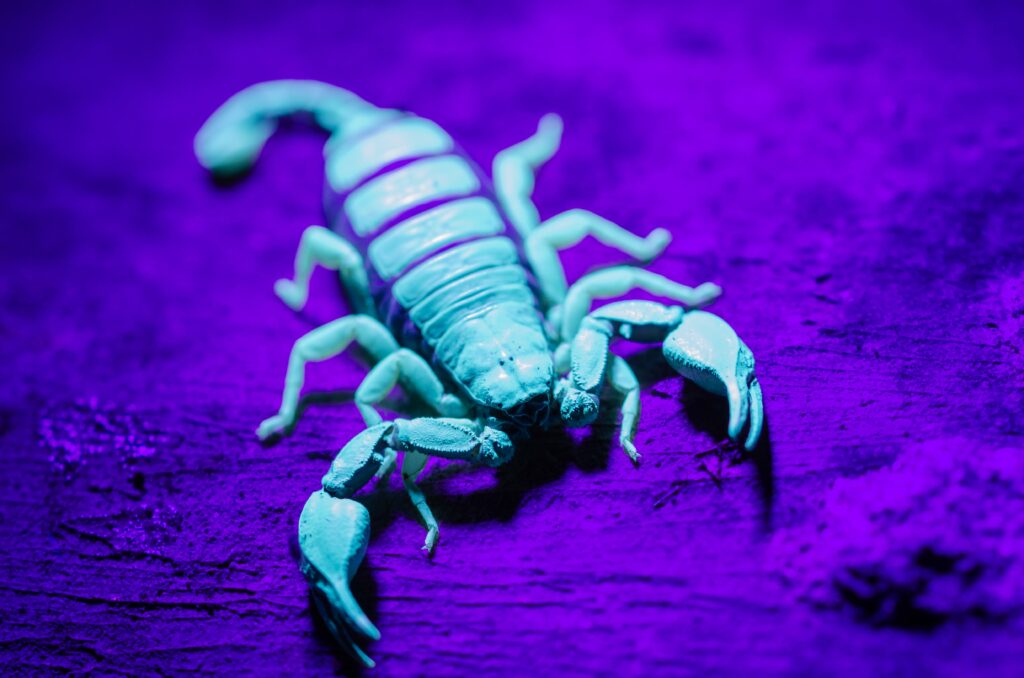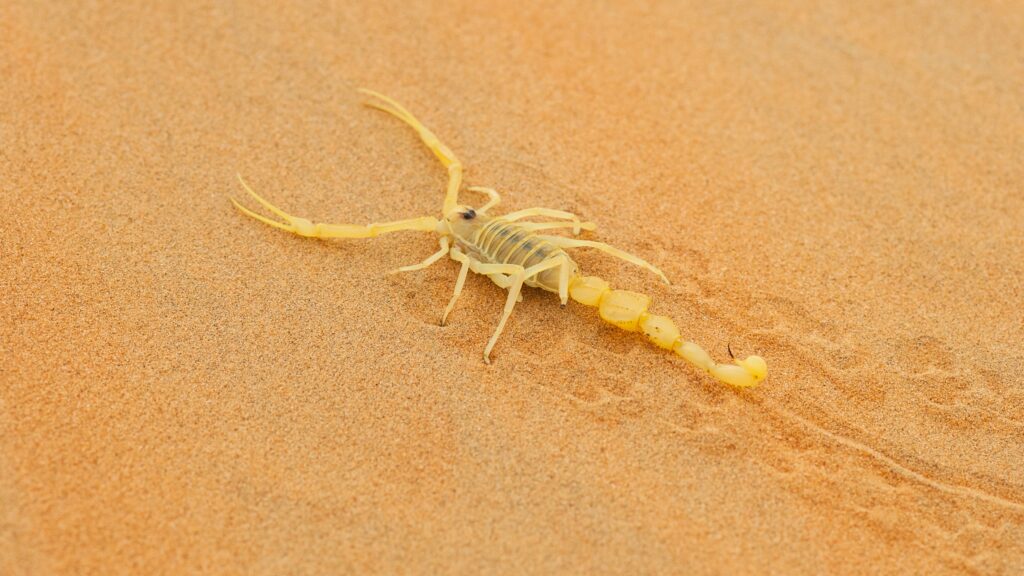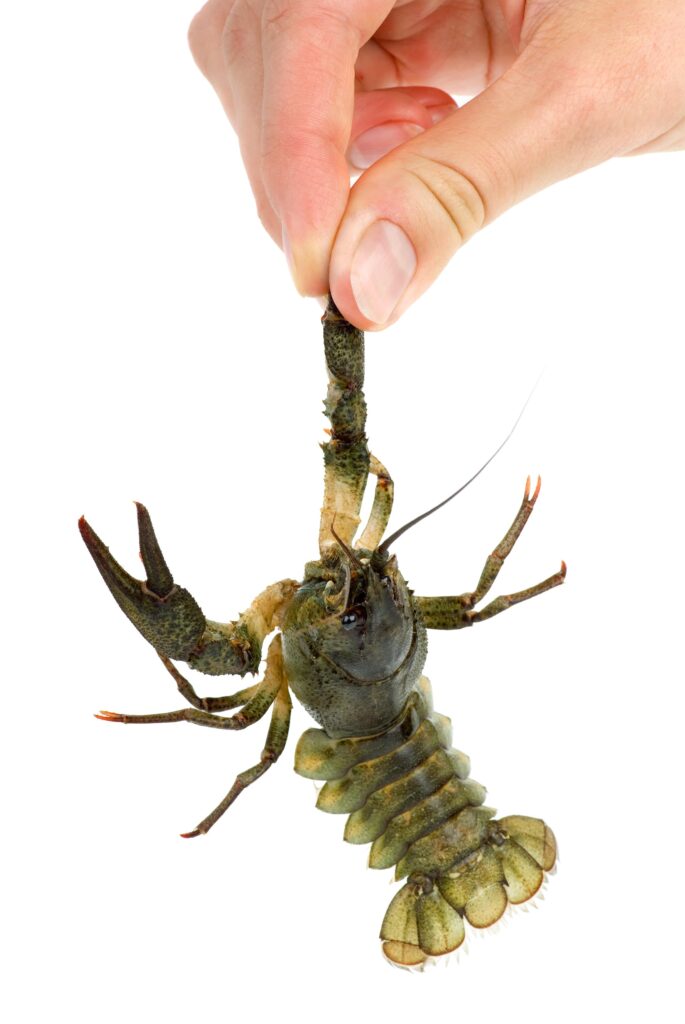Las Vegas, the entertainment capital of the world, is not just famous for its bright lights and casinos but also for its scorpion population. Yes, you read that right!
Scorpions are quite prevalent in the Las Vegas area, and understanding their behavior and habits has become a topic of fascination among locals and visitors alike. In this article, we will delve into the intriguing world of scorpions in Las Vegas and explore when these enigmatic creatures come out to play.
Overview of Scorpions in Las Vegas

Scorpions belong to the arachnid family and have been part of the Las Vegas desert ecosystem for centuries. The most common species found in this region is the bark scorpion (Centruroides exilicauda), known for its pale yellow coloration and venomous sting. While some might consider them pests, it’s important to note that bark scorpions also play a crucial role in maintaining ecological balance by preying on insects such as spiders, crickets, and cockroaches.
The warm summer desert climate provides an ideal habitat for scorpions to thrive. With long hot summers stretching from March till fall, these months mark peak scorpion activity periods in Las Vegas.
However, it doesn’t mean they completely disappear during colder months or warm winter either. Scorpions can adapt to lower temperatures by seeking shelter under rocks or inside crevices along walls or even within houses.
Fascination with Scorpion Behavior and Habits

The allure surrounding scorpions stems from their unique adaptations and intriguing behavior patterns. These nocturnal creatures are primarily active at night when they emerge from their hiding spots to hunt for prey or find suitable mates. Their exoskeletons fluoresce under ultraviolet light—a fascinating phenomenon that adds an eerie touch to encounters with scorpions.
Scorpions’ ability to survive in harsh desert environments has captivated scientists, nature enthusiasts, and even pest control companies. The intricacies of their breeding cycles, the impact of disturbances caused by urbanization on their habitats, and common misconceptions about their venomous nature have all contributed to the interest in studying these fascinating creatures further.
So, if you’ve ever wondered when scorpions come out in Las Vegas or how they behave in different seasons, keep reading as we delve deeper into the factors influencing their emergence and preferred habitats. Understanding these aspects will not only help demystify scorpions but also assist in implementing preventive measures to minimize encounters with them.
Scorpion Season in Las Vegas

Spring and Summer Months as Peak Scorpion Activity Period
When it comes to scorpions in Las Vegas, the spring and summer months are when these fascinating creatures truly come alive. As temperatures rise and the desert landscape blooms with life, scorpions begin to emerge from their hideouts to roam freely.
The peak of scorpion activity typically begins in March and continues through the summer months, gradually tapering off as autumn approaches. Las Vegas is home to several species of scorpions, but the most common one found in this area is the Arizona bark scorpion.
These nocturnal arachnids thrive in the warm desert climate characterized by mild winters and scorching summers. During their peak season, it’s not uncommon for residents to encounter a higher number of scorpions both indoors and outdoors.
Factors Influencing Scorpion Emergence
Several factors influence when and where scorpions emerge within Las Vegas. Temperature plays a crucial role, as these arachnids are ectothermic creatures that rely on external heat sources to regulate their body temperature. As temperatures rise above 70 degrees Fahrenheit (21 degrees Celsius), scorpions become more active, seeking out food sources and potential mates.
Another important factor influencing their emergence is breeding cycles and reproduction patterns. Mating season triggers increased sightings of adult male scorpions venturing out in search of females.
Female scorpions seek sheltered areas such as walls or beneath rocks to create nests for their offspring. It’s worth noting that disturbances caused by construction or landscaping activities can also drive scorpions out of hiding places unexpectedly.
As their natural habitats are disrupted, they may seek new shelter within residential areas, leading to an uptick in encounters with humans. Overall, understanding the seasonal patterns of scorpion activity can help residents be better prepared and take necessary precautions to prevent scorpions from entering their homes.
Factors Influencing Scorpion Emergence
Temperature and Weather Conditions: The Ideal Habitat

Scorpions, like many other creatures, have a preferred temperature range in which they are most active. In Las Vegas, scorpions enjoy the arid desert climate and thrive when temperatures are between 70 to 90 degrees Fahrenheit. These warm conditions provide the ideal habitat for scorpions to come out of hiding and begin to engage in their nocturnal activities.
During summer months, when temperatures soar above 100 degrees Fahrenheit, scorpions become more active during the cooler nights, seeking refuge during the scorching daytime heat. Conversely, during colder winter months when temperatures drop below 60 degrees Fahrenheit in Las Vegas (which is considered relatively cool), scorpions may enter a state of semi-hibernation or conserve energy by becoming less active.
Breeding Cycles and Reproduction Patterns: Nature’s Timing

The mating season plays a significant role in determining when scorpions emerge. Typically, scorpion breeding occurs during the spring and summer months when conditions are favorable for reproduction. The mother scorpion carries her offspring internally until they are ready to be born live – an unusual trait known as viviparity.
This process can take several weeks or even months depending on species and environmental factors such as temperature, humidity, and food availability. Once the young are born, they climb onto their mother’s back where she provides protection until they have undergone their first molt.
The Lifecycle Stages: Maturing into Active Hunters
A scorpion’s lifecycle consists of several stages from birth to adulthood. After being born or hatching from eggs (depending on species), baby scorpions go through multiple molts before reaching maturity.
During these stages of growth, they gradually shed their exoskeletons as they grow larger in size and develop stronger pincers and venomous stingers. The length of time it takes for a scorpion to mature varies between species but typically ranges from several months to a couple of years.
Once they have reached adulthood, scorpions become more active in their hunting and mating behaviors, emerging more frequently to search for food and potential mates. By understanding the factors that influence scorpion emergence, such as temperature, breeding cycles, and lifecycle stages, we can gain insight into when these fascinating creatures come out in Las Vegas.
So next time you’re pondering the question of “when do scorpions come out in Las Vegas,” remember that it’s when the weather is warm enough to entice them from their hiding spots and when nature aligns with their reproductive instincts. With this knowledge, you can take necessary precautions to prevent scorpion infestations and ensure a harmonious coexistence with these desert dwellers.
Nocturnal Nature of Scorpions

Adaptations for survival in the desert environment
Scorpions, those intriguing arachnids that roam the desert landscapes of Las Vegas, have evolved remarkable adaptations to thrive in their harsh, cold surroundings. One key adaptation is their nocturnal nature.
To survive the scorching daytime heat, scorpions have become primarily active during the night when temperatures are cooler and more tolerable. This behavior allows them to conserve energy and avoid dehydration, which is crucial in their arid habitat.
Avoiding daytime heat by being primarily nocturnal creatures
By adopting a strictly nocturnal lifestyle, scorpions can skillfully evade the sweltering sun rays that mercilessly beat down on the desert floor during daylight hours. This behavioral shift enables them to minimize water loss through evaporation and escape overheating. Instead, they emerge from their hiding spots as darkness falls and venture out into the cool night air to feed and explore their surroundings.
Unique sensory adaptations aiding night-time hunting
In addition to avoiding extreme temperatures, scorpions possess extraordinary sensory adaptations that enhance their hunting prowess under cover of darkness. Their exoskeletons contain a specialized layer able to reflect ultraviolet light, making these pesky pests glow when exposed to UV sources like blacklights. This feature aids both scientists studying them and homeowners trying to detect scorpion activity around their properties.
Moreover, scorpions have developed sensitive hairs on their legs called “trichobothria,” which act as receptors for detecting vibrations caused by nearby prey or potential threats. These microscopic sensors enable them to locate insects or small creatures even in pitch-black conditions.
Additionally, they possess unique pincers known as “pedipalps,” which function both as sensory organs and weapons for capturing prey. Scorpions have successfully adapted to the desert environment of Las Vegas by becoming nocturnal creatures.
This behavior allows them to avoid the scorching heat, conserve energy, and utilize their unique sensory adaptations for night-time hunting. By understanding their habits and adaptations, homeowners can take appropriate measures to prevent scorpions from intruding into their living spaces and enjoy a more peaceful coexistence with these fascinating creatures.
Preferred Habitats for Scorpions in Las Vegas
Desert Landscapes Providing Ideal Living Conditions

In the arid desert landscapes of Las Vegas, scorpions have found their perfect haven. The dry climate and sparse vegetation create an environment that suits their survival needs. The sandy soil prevalent in the region allows for scorpions nest well and for easy burrowing, providing shelter from extreme temperatures and predators.
Moreover, scorpions are well adapted to conserve water, crucial in an ecosystem where moisture is scarce. This ability allows them to thrive even in the harsh desert conditions.
Sandy Soil, Rocks, and Crevices as Preferred Hiding Spots
Scorpions have a natural instinct for seeking shelter and protection during the day when they are less active. Sandy soil provides an ideal substrate for burrowing and creating hidden tunnels where they can find refuge from predators and extreme temperatures.
Rocks and crevices also serve as convenient hiding spots during daylight hours. These natural features offer protection from both the scorching sun and potential threats.
It’s not uncommon to find scorpions tucked away under rocks or nestled within crevices of walls or trees. Their preference for these hiding spots stems from their nocturnal nature, as most scorpions are primarily active at night when they hunt for prey.
Impact of Urbanization on Their Habitats
As urbanization continues to expand throughout Las Vegas, it inevitably encroaches upon the natural habitats of scorpions. The construction of buildings, roads, and other infrastructure disrupts their preferred sandy soil environments and removes essential hiding places such as rocks or fallen logs.
Additionally, human activities generate artificial light sources that can interfere with the natural circadian rhythm of scorpions. These disruptions may alter their hunting patterns or expose them to increased predation risks.
While some species adapt to urban environments and find shelter in man-made structures, others struggle to find suitable habitats. Maintaining a balance between development and preserving natural habitats is crucial to ensure the continued survival of Las Vegas scorpion populations.
The desert landscapes of Las Vegas provide an ideal environment for scorpions to thrive. The sandy soil allows for easy burrowing, rocks, and crevices offer hiding spots during the day, and the dry climate suits their water-conserving adaptations.
However, urbanization poses challenges as it disturbs their natural habitats. Understanding these factors helps us coexist with these fascinating creatures while preserving their essential role in our ecosystem.
Scary or Harmless? Common Misconceptions about Scorpions
Distinguishing between venomous and non-venomous species
When it comes to scorpions, many people tend to immediately associate them with danger and venomous stings. While it’s true that some scorpions do have venom, it’s important to know that not all scorpion species are harmful to humans. In Las Vegas, the most common scorpion species you’ll come across is the Arizona bark scorpion (Centruroides sculpturatus).
This particular scorpion is indeed venomous and possesses a sting that can cause severe pain and discomfort. However, other species found in the area, such as the Desert Hairy Scorpion (Hadrurus arizonensis), have a weaker venom that generally poses no significant threat to humans.
To identify whether a scorpion is venomous or not, look out for certain characteristics. Venomous scorpions typically have slender pincers and elongated tails with a distinctive curve at the end, ending in a sharp stinger.
In contrast, non-venomous scorpions often have thicker pincers and shorter tails with less curvature. It’s always wise to exercise caution around any unknown scorpion species and avoid handling them without proper knowledge or expertise.
Myths surrounding the danger posed by Las Vegas scorpions

Las Vegas has gained a reputation for its desert-dwelling creatures like rattlesnakes and tarantulas, but some misconceptions about the dangers of its local scorpions need debunking. One common myth is that every encounter with a Las Vegas scorpion will result in a painful sting or worse.
This simply isn’t true. While it’s essential to take precautions when living in an area where these critters reside, most encounters with Las Vegas scorpions are harmless.
Another myth suggests that scorpions are vicious creatures that actively seek out humans to attack. In reality, scorpions tend to be more interested in finding shelter, food, and water rather than seeking out a confrontation with humans.
They primarily come into contact with people when they accidentally enter homes or when humans unknowingly disturb their hiding places. By taking preventative measures like sealing cracks around your home’s exterior doors, reducing clutter in your living space, and removing potential hiding spots both inside and outside your property, you can significantly minimize the chances of encountering a scorpion indoors.
It’s crucial to understand that while Las Vegas scorpions may startle you if you stumble upon them unexpectedly, most species are more interested in avoiding conflict rather than engaging in it. By distinguishing between venomous and non-venomous species and dispelling myths about their behavior, we can coexist peacefully with these fascinating desert dwellers while reducing the fear associated with their presence in our homes and surroundings.
Tips for Dealing with Scorpions in Las Vegas
Preventive measures to minimize encounters at home
When it comes to keeping scorpions at bay in Las Vegas, prevention is key. By taking a few simple steps, you can significantly reduce the chances of these arachnids coming into your living space. One effective method is sealing cracks, gaps, and entry points into your house.
Scorpions are remarkably adept at squeezing through even the tiniest openings, so pay close attention to door frames, windowsills, and any other potential entryways. Weather stripping and caulk can be your best friends in this battle against unwanted winter scorpion guests.
Reducing clutter and removing potential hiding spots

Scorpions are cunning creatures that love to hide in cluttered areas. To minimize their presence inside your home, it’s important to keep things tidy and organized.
Start by decluttering storage spaces like garages, basements, and closets where scorpions might find refuge among boxes and piles of items. Be mindful of clothes left on the floor or shoes lying around since these can make for cozy hiding spots as well.
Remember that scorpions are attracted to dark places where they feel safe from predators. By reducing their hiding spots, you’ll create an environment that’s far less appealing to them.
Conclusion
While the thought of encountering a scorpion may be unsettling for many people in Las Vegas, there are practical steps you can take to mitigate the risk of seeing these critters inside your home. By sealing cracks and gaps as well as reducing clutter that could serve as hiding spots for scorpions, you’ll greatly decrease their chances of making themselves unwelcome houseguests.
Keep in mind that pest control companies have experience dealing with scorpion problems should you need professional assistance. Remember, scorpions are just one small part of Las Vegas’s vibrant ecosystem, and with some simple precautions, you can enjoy the city without letting these little creatures sting your peace of mind.
Overcome Scorpion Infestations with D-Termination: Las Vegas’ Leading Pest Control Solution:

roubled by scorpions taking over your Las Vegas property? Rest easy, for D-Termination is at your service. Our team of skilled professionals is dedicated to eradicating these venomous pests, ensuring the restoration of safety and peace to your environment. Bid farewell to scorpion-related concerns—opt for D-Termination’s effective pest control services today!
To schedule your scorpion control service and regain control over your space by banishing these unsettling pests, reach out to us at 702-919-6310 or visit dtermination.com.
Frequently Asked Questions:
Scorpions on the Las Vegas Strip are relatively uncommon due to the urban environment.
Scorpions are most active during the warmer months, from spring to fall.
Yes, scorpions are commonly found in the Las Vegas region, especially in desert areas.
Scorpions are attracted to Las Vegas due to its desert climate, warmth, and potential hiding spots.







